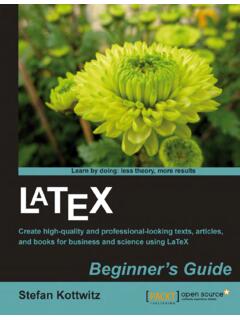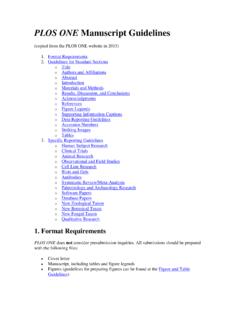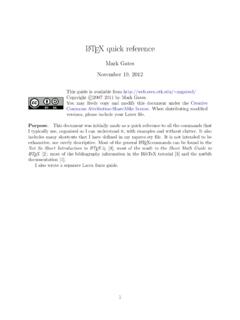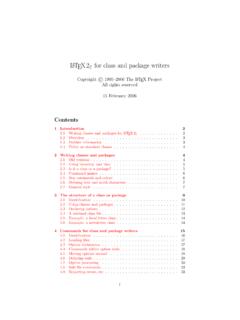Transcription of TheNotSoShort IntroductiontoLATEX2 - OETIKER
1 The Not So ShortIntroduction to LATEX2 Or LATEX2 in139minutesby Tobias OetikerHubert Partl, Irene Hyna and Elisabeth SchleglVersion , March 09, 2021iiCopyright 1995-2021 Tobias OETIKER and Contributors. All rights document is free; you can redistribute it and/or modify it under the termsof the GNU General Public License as published by the Free Software Foundation;either version 2 of the License, or (at your option) any later document is distributed in the hope that it will be useful, butwithoutany warranty; without even the implied warranty ofmerchantabilityorfitness fora particular purpose.
2 See the GNU General Public License for more should have received a copy of the GNU General Public License along withthis document; if not, write to the Free Software Foundation, Inc., 51 FranklinStreet, Fifth Floor, Boston, MA 02110-1301, you!Much of the material used in this introduction comes from an Austrianintroduction to latex written in German by:Hubert Informatikdienst der Universit t f r Bodenkultur WienIrene f r Wissenschaft und Forschung WienElisabeth Schlegl<noemail>in GrazIf you are interested in the German document, you can find a versionupdated for latex 2"by J rg Knappen atCTAN://info/lshort/germanivThank you!
3 The following individuals helped with corrections, suggestions and materialto improve this paper. They put in a big effort to help me get this documentinto its present shape. I would like to sincerely thank all of them. Naturally,all the mistakes you ll find in this book are mine. If you ever find a wordthat is spelled correctly, it must have been one of the people below droppingme a you want to contribute to this booklet, you can find all the sourcecode Your pull requests will Abrahamsen, Lenimar Nunes de Andrade, Eilinger August, Rosemary Bailey,Barbara Beeton, Marc Bevand, Connor Blakey, Salvatore Bonaccorso,Pietro Braione, Friedemann Brauer, Markus Br hwiler, Jan Busa, David Carlisle,Neil Carter, Carl Cerecke, Mike Chapman, Pierre Chardaire, Xingyou Chen,Christopher Chin, Diego Clavadetscher, Wim van Dam, Benjamin DeschwandenJan Dittberner.
4 Michael John Downes, Matthias Dreier, David Dureisseix,Hans Ehrbar, Elliot, Rockrush Engch, William Faulk, Robin Fairbairns,Johan Falk, J rg Fischer, Frank Fischli, Daniel Flipo, Frank, Mic Milic Frederickx,David Frey, Erik Frisk, Hans Fugal, Robert Funnell, Greg Gamble, Andy Goth,Cyril Goutte, Kasper B. Graversen, Arlo Griffiths, Alexandre Guimond,Neil Hammond, Christoph Hamburger, Rasmus Borup Hansen, Joseph Hilferty,Daniel Hirsbrunner, Martien Hulsen, Bj rn Hvittfeldt, Morten H gholm,Werner Icking, Eric Jacoboni, Jakob, Alan Jeffrey, Martin Jenkins, Byron Jones,David Jones, Johannes-Maria Kaltenbach, Nils Kanning, Andrzej Kawalec,Christian Kern, Alain Kessi, Axel Kielhorn, Sander de Kievit, Kjetil Kjernsmo,Tobias Klauser, J rg Knappen, Michael Koundouros, Matt Kraai, Tobias Krewer,Flori Lambrechts, Mike Lee, Maik Lehradt, R mi Letot, Axel Liljencrantz,Jasper Loy.
5 Johan Lundberg, Martin Maechler, Alexander Mai, Claus Malten,Kevin Van Maren, Pablo Markin, I. J. Vera Mar n, Hendrik Maryns,Chris McCormack, Aleksandar S. Milosevic, Henrik Mitsch, Stefan M. Moser,Armin M ller, Philipp Nagele, Richard Nagy, Manuel OETIKER , Urs Oswald,Hubert Partl, Marcelo Pasin, Martin Pfister, Lan Thuy Pham, Breno Pietracci,Demerson Andre Polli, Maksym Polyakov, Nikos Pothitos, John Refling,Mike Ressler, Brian Ripley, Kurt Rosenfeld, Bernd Rosenlecher, Chris Rowley,Young U. Ryu, Risto Saarelma, Andr s Salamon, Jos Carlos Santos,Christopher Sawtell, Gilles Schintgen, Craig Schlenter, Hanspeter Schmid,Baron Schwartz, John Scott, Jordi Serra i Solanich, Miles Spielberg,Susan Stewart, Matthieu Stigler, Geoffrey Swindale, Laszlo Szathmary,Boris Tobotras, Josef Tkadlec, Scott Veirs, Didier Verna, Carl-Gustav Werner,Fabian Wernli, Matthew Widmann, David Woodhouse, Chris York, Rick Zaccone,Fritz Zaucker, and Mikhail [1] is a typesetting system that is very suitable for producing scien-tific and mathematical documents of high typographical quality.
6 It is alsosuitable for producing all sorts of other documents, from simple letters tocomplete books. latex uses TEX [2] as its formatting short introduction describes latex 2"and should be sufficient formost applications of latex . Refer to [1,3] for a complete description of theLATEX introduction is split into 6 chapters:Chapter 1tells you about the basic structure of latex 2"documents. Youwill also learn a bit about the history of latex . After reading thischapter, you should have a rough understanding how latex 2goes into the details of typesetting your documents. It explainsmost of the essential latex commands and environments.
7 After read-ing this chapter, you will be able to write your first documents, withitemized lists, tables, graphics and floating 3explains how to typeset formulae with latex . Many examplesdemonstrate how to use one of latex s main strengths. At the endof the chapter are tables listing all mathematical symbols available 4explains indexes, bibliography generation and some finer pointsabout creating 5shows how to use latex for creating graphics. Instead of draw-ing a picture with some graphics program, saving it to a file and thenincluding it into latex , you describe the picture and have latex drawit for 6contains some potentially dangerous information about how toalter the standard document layout produced by latex .
8 It will tell youhow to change things such that the beautiful output of latex turnsugly or stunning, depending on your is important to read the chapters in order the book is not that big, afterall. Be sure to carefully read the examples, because a lot of the informationis in the examples placed throughout the is available for most computers, from the PC and Mac to large UNIXand VMS systems. On many university computer clusters you will find thata latex installation is available, ready to use. Information on how to accessthe local latex installation should be provided in theLocal Guide[5].
9 If youhave problems getting started, ask the person who gave you this scope of this document isnotto tell you how to install and set up aLATEX system, but to teach you how to write your documents so that theycan be processed by you need to get hold of any latex related material, have a look at one ofthe Comprehensive TEX Archive Network (CTAN) sites. The homepage will find other references to CTAN throughout the book, especiallypointers to software and documents you might want to download. Insteadof writing down complete URLs, I just wroteCTAN:followed by whateverlocation within the CTAN tree you should go you want to run latex on your own computer, take a look at what isavailable you have ideas for something to be added, removed or altered in thisdocument, please let me know.
10 I am especially interested in feedback fromLATEX novices about which bits of this intro are easy to understand andwhich could be explained AGAarweg 154600 OltenSwitzerlandThe current version of this document is available onCTAN://info/lshortContentsThank you!iiiPrefacev1 Things You Need to A Bit of History.. TEX.. latex .. Basics.. Author, Book Designer, and Typesetter.. Layout Design.. Advantages and Disadvantages.. latex Input Files.. Spaces.. Special Characters.. latex Commands.. Comments.. Input File Structure.. A Typical Command Line Session.






